
An independent travel blog helping you to visit off the beaten track destinations

Guide to Southern Turkey (Anatolia): Why Visit / Itinerary

This guide summarizes why to visit , when to visit , safety , visas , how to get in , how to get around and a sample two-week itinerary . Excellent news, there are many reasons to visit southern Turkey. Everybody, from young to old, history buff to nature lover or foodie, will find plenty.
Why visit Anatolia?
If you are looking for a region with outstanding history over the last few millenia, excellent food, natural scenery with few, if any, Western tourists, south-eastern Turkey is the place for you. The history spans a few millenia with Hittites, Frygians, Parthans, Greeks, Romans, Crusaders and Ottomans all making their mark in religion, culture, cities and food. In south-eastern Turkey you can actually see the remaining of their civilizations within a few hours drive from each other. All without crossing any borders in a stable and safe environment with relaxed visa requirements. In addition, the flight/coach/bus/minibus transportation is excellent. There is a broad spectrum of accommodations for any budget. Food is varying and outstanding. There are few foreign tourists, and people are nice to you.
No masses of Western tourists or tours are creating two outstanding effects.
(1) Anatolia is inexpensive
Firstly, the area is inexpensive and great value. You can find a dorm bed for $10 or less, and a quality 3* hotel room for $20, which would easily be at least twice the cost in western Turkey. This is still a region where there is no double-tier pricing system for tourists. You will not be charged five / thirty times the local rate (hello Indonesia park entry tickets). There are also few venues geared towards the Western guests with the usual tourist traps. A glass of excellent refreshing limonata in Sanliurfa perfect to quench your thirst will still cost you $0.15 regardless if you are a tourist and easily recognizable as one.
(2) Not over-commercialized yet
Secondly, most of the time you will be treated in a “normal” way and not as a potential source of overcharged prices. It seems that most people will want to talk to you because of the genuine interest in this random Western tourist, who ventured off-the-beaten track to visit their city. Because there are few foreign tourists, especially after the pandemic, you will be appreciated that you came to southern Turkey. You will be invited to tens glasses of tea with the customary questions:
- “do you like Turkey?”
- “do you like <insert the current city here>?”
- “what do you like in <insert the current city here>?”
- or, the slightly sensitive one, “is our food better than in <insert the next major city>?”.
And the weird thing is that this will be in many cities there, not just one. Of course, there will be differences but, in general, a breath of fresh air after the standard heavily commercialized tourist heavens.
Please go and visit. And please go and visit now. Before the waves of the Western tourists descend.
When to visit Anatolia?
The climate in south-eastern Turkey is chilly winters and scorching hot summers. The best time is mid-April to mid-June and late September to early November.
Guide to Turkey: Safety
I have not had any uncomfortable encounters, even though I was frequently walking late at night. I have not witnessed any attempted thefts or any aggression on the streets.
Guide to Turkey: Visas
Tourists from the EU, United Kingdom, Argentina, Brazil, Colombia, and many others are “exempted from visa up to 90 days in any 180-day period”. Citizens of the United States, Australia, People’s Republic of China do need a visa.
A comprehensive country list with the corresponding visa requirements is attached in this website of the Turkish Ministry for Foreign Affairs:
https://www.mfa.gov.tr/visa-information-for-foreigners.en.mfa
A link to the evisa website is attached below. The evisa application is relatively straightforward, with three steps (application, payment, visa download), credit card payment is enabled. You will receive the visa emailed to your address.
https://www.evisa.gov.tr/
Guide to Turkey: Get In
All major cities in Anatolia have good transportation links:
Turkish Airlines, Pegasus Airlines, Corendon Airlines and SunExpress are the major airlines in Turkey . Turkish Airlines is a more premium offering with the remaining more similar to Southwest, Spirit and Frontier in the U.S. or Ryanair in Europe.
Major cities have their own regional airports differing in the distance to city center. The transportation choices to the city center are usually (a) Havas airport bus, (b) shuttle bus, (c) taxi (unfortunately, no subway or train connections). Please find the detailed information in the corresponding city sections.
(2) Coach / Bus
Turkey has a well-developed long-distance bus / coach system . Especially on the longer-distance connections, buses / coaches are modern Mercedes / etc. vehicles with air conditioning, wifi and a stewart serving tea (unlikely on Greyhound, National Express or Megabus!). Instead of the 2+2 seat arrangement prevalent on the U.S. and European buses, many buses have a 2+1 setup.
The long-distance coach bus system is run not by one centralized company, but many local enterprises competing on overlapping routes . Some long-distance coach stations are conveniently located in the city center (e.g., Denizli), but many are miles away (e.g., Sanliurfa, Diyarbakir), and you have to take a minibus (e.g., Diyarbakir, Mardin) or a city bus (e.g., Sanliurfa) for approximately $0.30 one way.
The individual coach companies are hub-based (e.g., Mardin Seyahat, Oz Diyarbakir). Therefore, the coaches from the local company start on time with no delays as they do not connect from another city. After I had waited for a coach delayed by two hours at midnight in Kayseri, I have always tried to take a local hub coach just starting its ride.
There are differences among various coach companies in punctuality, comfort, wifi speed and seat arrangement (2+1 vs 2+2). The prices are generally similar, but higher for the higher-quality companies by up to 10-20%. I liked for example Kamil Koç or Ben Turizm.
Be prepared, Turkey is a vast country and the distances are long . In the end, I considered a 2-3 hour bus ride short, 4-5 medium and anything over 8 long. A special mention to some overnight buses with unstable air conditioning and blasting local music at 4am.
(3) Minibus (dolmus pronounced “DOL-moosh”)
An efficient system popular in the region of e.g., Mercedes minibuses, which depart when full. If your dolmus is not going where you want to go, there will be another one (or three), which will get you exactly where you want to be. It might be annoying that they are actively searching for additional passangers on the road and you might feel they are stopping every 60 seconds. On the other hand, they will drop you off at any point you wish (well, probably not exactly at a roundabout but almost anything else works).
Unfortunately, there is no well-developed train system in south-eastern Turkey. A similar setup as in e.g., Izmir in western Turkey, would be welcome.
Guide to Turkey: Get Around
(1) walking.
By far my preferred method of transportation in south-eastern Turkish cities. Suppousedly excedingly healthy, environmentally-friendly and relatively cheap. Probably most importantly, the best way to observe and meet the people and “soak the local atmosphere”. Those Mesopotamian cities are thousands of years old, so they are relatively compact and walkable. Also, many/most historical sites are within the old city limits or the existing city walls (e.g., Diyarbakir).
(2) Minibus (dolmus)
Same logic as above, no prior reservation required. You might have to be a bit patient but a dolmus (or three) will get you to wherever you want to be. Even in the smallest village in Anatolia.
Available everywhere, most in the familiar yellow color. Always determine the approximate cost before (rome2rio.com a good start).
NEVER enter a taxi BEFORE agreeing on the total cost to your final destination. This includes your luggage. Do not let it be put into the trunk BEFORE you agreed on the price.
Negotiate / haggle if you think overpriced. This is expected, do not disappoint the drivers by accepting inflated prices. You will also do a disservice to the other tourists in the future.
South-eastern Turkey Itinerary (2 weeks)
Nemrut Dagi – Sanliurfa (Urfa as is commonly known) – Mardin – Diyarbakir – Gaziantep (Antep) – Hatay (Antakya / Antioch)
Day 1-2: Guide to Nemrut Dagi, Turkey (2022)
Day 3-5: Sanliurfa and Göbekli tepe (11,000 years old!)
Day 6-7: Mardin: ancient Silk Road town
Day 8-9: Diyarbakir
Day 10-12: Gaziantep (Zeugma mosaics and best food in Turkey)
Day 13-14: Hatay: kunefe desert and Greek mosaics
Share this:

- Share on Tumblr
6 thoughts on “Guide to Southern Turkey (Anatolia): Why Visit / Itinerary”
bu web sayfasında Türkiye ile ilgili okuduklarınız mükemmel bir özet ve sizler için kolaylık olmuş. Ulaşımdan gezilecek yerlere konaklamadan yemeklere kadar oluşan bu rehber sizin için fazlasıyla yeterli olacaktır.
Hi again Yunus, I have to admit I had to use an online translator. Thank you again for your kind words and the inspiration.
What you have read about Turkey on this web page is an excellent summary and has been a convenience for you. From transportation to places to visit, from accommodation to meals, this guide will be more than enough for you.
Hi Yunus, thank you for your comment. Very motivating to keep writing and improving my posts.
Definitely this will be my main reference before traveling to Anatolia in shaa Allah.
I always struggle with transportation choices, even in my home country , but you make it looks very easy to deal with.
I’ll be waiting for your next trips hopefully you enjoy them too.
Best regards
Hi Muhammand, thank you for your kind words. I am sure you will like Anatolia a lot. Best wishes
Leave a Reply Cancel reply
Your email address will not be published. Required fields are marked *
Save my name, email, and website in this browser for the next time I comment.
Notify me of follow-up comments by email.
Notify me of new posts by email.
This site uses Akismet to reduce spam. Learn how your comment data is processed .
Heilbrunn Timeline of Art History
- Works of Art
Anatolia and the Caucasus, 1000–1400 A.D.
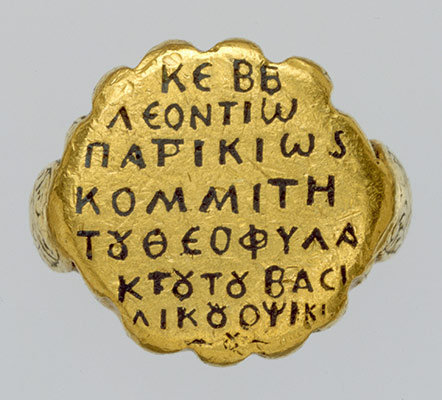
The period from 1000 to 1400 in Anatolia and the Caucasus is a time of Turkic and Muslim expansion at the expense of the Byzantine empire’s eastern territories. The arrival of the Crusaders from the west, especially the conquest of Constantinople by the Fourth Crusade in 1204, further undermines the civil authority of the Byzantine state. The advance of the Mongol armies from the east also fragments power in the region. Anatolia will not be reunified until the Ottoman conquests in the late fifteenth century. The plurality of the period, however, brings cross-cultural exchange and innovations in the arts as well as architecture.
Under the Byzantine emperor Basil II (r. 976–1025), western Armenian territories are annexed and Byzantium reaches its greatest medieval extent.
The defeat of the Byzantine army by Seljuq forces at the Battle of Manzikert (in present-day eastern Turkey) leads to the penetration, settlement, and conquest of Anatolia by Turkic tribes. At this time, Armenia passes under Seljuq rule, while Georgia expands its control over the Caucasus. A branch of the Seljuqs establishes its own realm in Anatolia and rule from Nicaea (modern Iznik). The Turkic/Muslim expansion prompts the First Crusade .
The relics of Saint Nicholas, patron saint of seafarers, are stolen by Italian sailors from his patron church in Myra on the Mediterranean coast of Anatolia and transported to Bari in southern Italy, where the saint’s cult flourishes.
At the invitation of the Byzantine court, the first Crusaders arrive in Anatolia en route to the Holy Land. Their capture of Nicaea (Iznik) forces the Anatolian Seljuqs to find a new capital, which is eventually established in Konya (1116).
Two branches of the Artuqid dynasty rule in southeastern Anatolia. Architecture and the arts, especially metalwork and textiles, reflect Seljuq influences and contact with Byzantium and the Crusaders.
The city of Ephesus serves as a staging point for the Second Crusade , en route to the Holy Land.
A period of tremendous cultural activity in Anatolia, with a synthesis of different immigrant traditions; important personages include Ibn al-‘Arabi (philosopher), Maulana Jalal al-Din al-Rumi (spiritual leader), and Yunus Emre (poet).
Byzantium is conquered and occupied by Western armies of the Fourth Crusade . As plunders of war, Byzantine works of art are dispersed throughout the Western medieval world. In place of a centralized Byzantine government, with its one capital in Constantinople, independent Byzantine states in exile are established in the former imperial provinces: the empire of Nicaea (1204–61), the empire of the Grand Komnenoi at Trebizond (1204–1461), and the despotate of Epirus (1204–1318).
The zenith of Anatolian Seljuq power. Besides centralization and military expansion, trade and artistic creativity also define this period. The caravanserais built for traveling merchants, as well as the architectural activity during the reign of ‘Ala’ al-Din Kai Qubad I (r. 1219–37), including his palace and mosque in Konya, are especially noteworthy.
The Golden Horde khanate rules the western part of the Mongol empire in the Caucasus and the Volga basin north of the Black and Caspian seas. At its greatest extent, the khanate stretches from the Danube to the River Irtysh in Siberia.
The Seljuqs are defeated by the Ilkhanids , the Mongol dynasty ruling in Iran, at the Battle of Köse Dagh, and are forced to pay a large tribute; Anatolia becomes closely linked to Iran politically, culturally, and artistically.
A new Byzantine emperor, Michael VIII Palaiologos (r. 1259–82), emerges from exile in the state of Nicaea and recovers Constantinople, reestablishing the empire on a much reduced scale.
Dozens of independent regional principalities, including the Osmanli (Ottomans) in northwestern Anatolia, replace the relative unity of Seljuq rule and become prominent after the fall of the Ilkhanids. While this fragmented power continues until Ottoman supremacy in the late fifteenth century, the courts of these regional dynasties provide multiple centers of artistic patronage.
With the move of its capital to Kutaisi, the western Georgian kingdom enters a period of increased diplomacy and trade with the empire of the Grand Komnenoi at Trebizond.
The Grand Komnenoi form marriage alliances between Byzantine princesses in Trebizond and Turkmen rulers in the east.
Reign of Bayezid I (“the Thunderbolt”), the Ottoman ruler whose conquests in Anatolia and the Balkans bring on the fatal battle against Timur (Tamerlane), the great Turko-Mongol ruler. Bayezid is equally ambitious in his patronage, which is exemplified by the Great Mosque of Bursa (1396–1400).
“Anatolia and the Caucasus, 1000–1400 A.D.” In Heilbrunn Timeline of Art History . New York: The Metropolitan Museum of Art, 2000–. http://www.metmuseum.org/toah/ht/?period=07®ion=waa (October 2001)
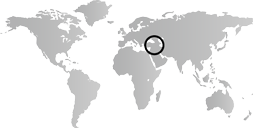
Primary Chronology
- Anatolia and the Caucasus, 500–1000 A.D.
- Anatolia and the Caucasus, 1400–1600 A.D.
Secondary Chronology
- Balkan Peninsula, 1000–1400 A.D.
Lists of Rulers
- List of Rulers of Byzantium
- List of Rulers of the Islamic World
- All essays related to Anatolia and the Caucasus, 1000–1400 A.D.
- All works of art from Anatolia and the Caucasus, 1000–1400 A.D.
- Anatolia and the Caucasus
- Islamic Art
- Islamic Art in the Medieval Period
- Istanbul (Constantinople)
- Medieval Art
- Ottoman Art
- 11th Century A.D.
- 12th Century A.D.
- 13th Century A.D.
- 14th Century A.D.
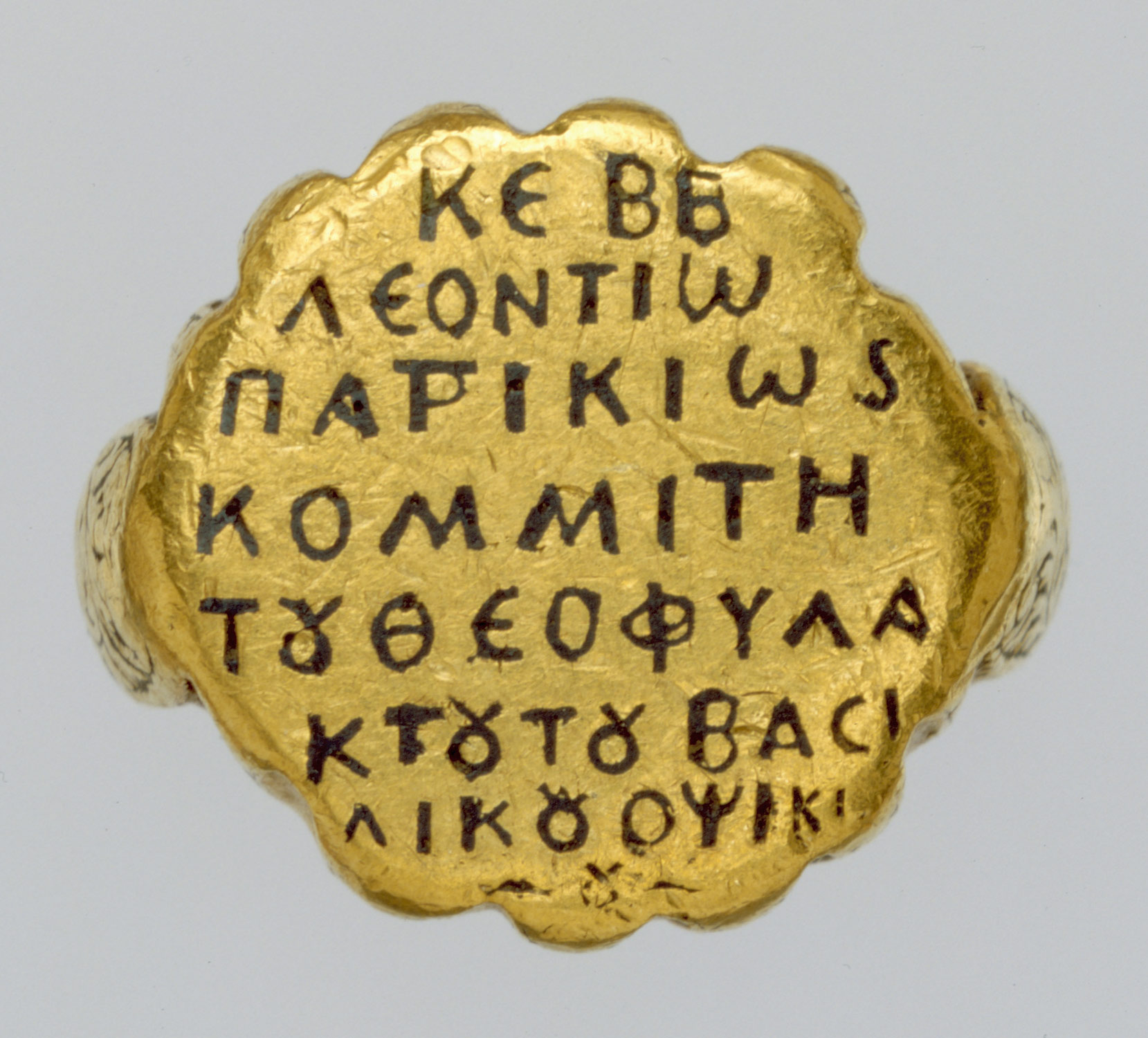
Ring of Leontios
Medallion with christ from an icon frame, tile panel with sphinx, capital with bust of the archangel michael, leaf from a gospel book with four standing evangelists, title page of the gospel of john, confronted animal rug, tympanum with a horse and rider.
Tourism & Travel Agency

Please visit website anatoliatravelservices.com and kindly download the "Checklist Form" from "Downloadable Documents". After click on "Visa Application Process" you will get to know the document requirements for different visa categories or you may visit our Visa Application Centers located in Islamabad, Karachi, Lahore, Peshawar, Sialkot, Gujranwala, Faisalabad and Hyderabad.
Kindly bring all documents mentioned on Embassy/Consulate checklist as per your desired visa category.
Online Visa Application Form will be only filled at Anatolia Visa Application Centers as free of cost in accordance with the information given by the applicant. Basic requirements:
Your valid passport for minimum 6 months (From the date of travel)
2 photographs with white background (5cm x 5cm). Front pose without sunglasses, veil, cap, turban (80% face - 20% body).
Other mandatory and supporting documents mentioned on Embassy / Consulates checklist as per your desired visa category.
Please download ´´Travel History Form´´ from our website and bring original copy after completing your last 5 years travel details before coming to our Visa Application Center to save your precious time for submission of visa application process (Only applicable for Punjab, Sindh and Baluchistan resident applicants).
Please be informed that biometrics are mandatory for each applicant age of 12 years and above including individuals, families and Corporate Groups w.e.f. 1st March, 2022 at Anatolia across Pakistan. However, applicant’s age of less than 12 years are exempted from biometrics. Therefore, personal appearance is mandatory for the applicant’s age of 12 years and above. In family visa applications, applicants over age of 18 years must sign their visa application forms at Anatolia.
When you arrive at the Visa Application Center, you will take a token and wait for your turn. Your token number is called to submit your visa application at the submission counter. During submission of visa application, you will be given an interview form to be filled manually (only applicable for Punjab, Sindh and Baluchistan resident applicants).
After submission of your visa application, you will proceed to Biometrics booth for fingerprints and live photo. After that, you will proceed to cash counter for payment of visa fee and Anatolia service charges in cash (PKR). In the meantime, submission staff will complete online visa application form filling to be signed by each applicant.
Pay cash for your visa processing fees at the cash counter and get payment receipt. Please retain this original payment receipt until you get back your passports/documents from the Visa Application Center.
Kindly bring all the supporting documents mentioned on Embassy/Consulate checklist as per your desired visa category.
1) Foreigner passport holders must have at least one month valid visa and duration of stay in Pakistan from the date of submission at Anatolia Visa Application Center.
2) For Afghan Nationals, Pakistani visa should be valid for minimum 90 days at the time of submission at Anatolia visa application center and their passport must be valid for 180 days from the date of travel.
3) For group visa applications, visa application process will remain the same except interview form. Please be informed that “Group means a company who is sponsoring its employees / franchises / dealers / distributors etc. On incentive trip and taking care of all their boarding and lodging expenses.” Different group families traveling together is not consider as group.
Our consultancy in visa application:
- Visa consultancy fee per person: 10,000 PKR only.
We help you in preparing your file for visa application and provide with you with following mandatory documents required by Turkiye visa policy.
- Visa Request letter
- Hotel Reservation
- Ticket Reservation
However, the rest of the documents will be provided by the applicant at the visa office (As per required by your visa category).
After completion of documents, the applicants with age more than 12 years must have to visit the Anatolia Travel services office for visa application submission.
- Visa processing charges (required to be submitted at Anatolia office):
- Single entry: 60 USD (Embassy Fee) + 65 USD (Anatolia services fee) + 55 USD (Insurance 3 months) -/per applicant
- Multiple entry: 190 USD (Embassy fee) + 65 USD (Anatolia services fee) + 80 USD (Insurance 1 year) -/per applicant
- Travel insurance bought from the Anatolia travel services will be accepted ONLY.
- Travel Insurance of 3 months is mandatory for single entry visa application and 1 year travel insurance is mandatory for multiple entry visa application.
For further details and information please contact us at:
WhatsApp: 0333-1904039 Phone: 051-2375301
APPLICATION PROCESS
© 2022 seferturk.com

Your next Adventure starts now…
Let’s build your personal journey!
My journey Package
City Adventures
Sea Adventures
ANATOLIA is full of ART, HISTORY, ADVENTURE, BEAUTY and LOVE ❤️
Adventure for your Soul
“We live in a wonderful world that is full of beauty, charm and adventure. There is no end to the adventures that we can have if only we seek them with our eyes open.” – Jawaharlal Nehru
Travel Anatolia
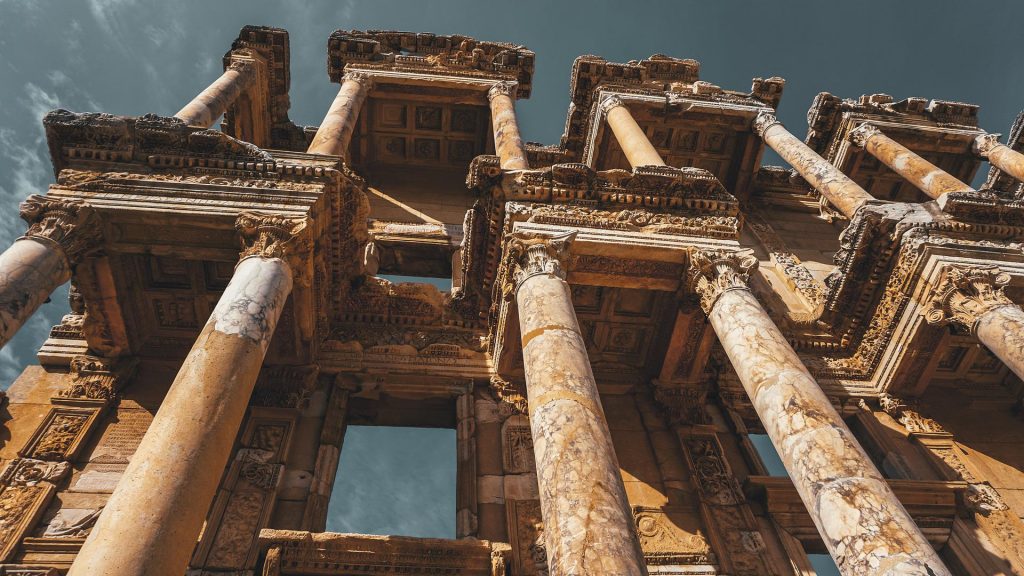
LET’s plan your travel.
TRAVEL ANATOLIA
A top service.
Once receiving your order, we will arrange a call with you to arrange the best for you.
Best Community
We have a long-standing reputation as one of the best travel communities in the world.
Relax & Enjoy
We make commitments that the quality of our work will and always will be superb.

EXPAND YOUR SENSES
Enjoy Turkish Cusine
To Do’s:
- Food Tours: Food Tours in Turkey
- Cooking Classes: Cooking Classes in Turkey
MUST-TRY’S:
- TURKISH BREAKFAST
- TURKISH SNACKS
- MEAT / SEAFOOD DISHES
- VEGETARIAN DISHES
- TURKISH DESSERTS
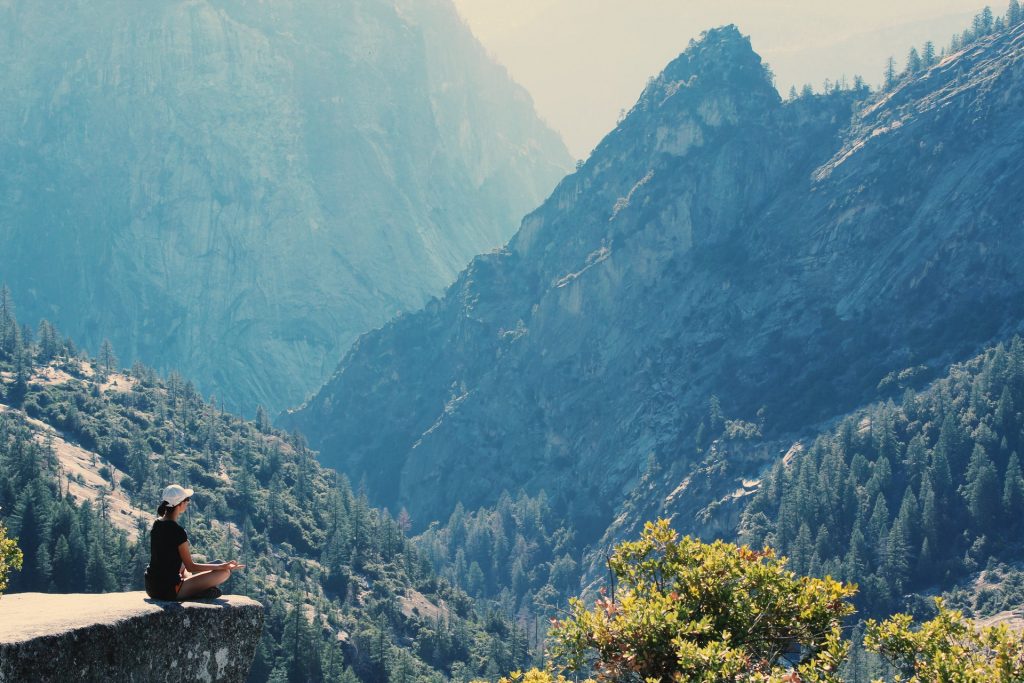
TAKE A MOMENT
Pure Nature & You…
Take a moment to enjoy Anatolia’s amazing nature.
Some of the Cool spots:
- Kleopatra Beach
- Saklikent National Park
- Goreme National Park
- Olympus (Lycia)
Go on an adventure from your inbox

You must turn on JavaScript in order to use this website.
You are using an outdated browser and some features of this website may not work correctly. Please upgrade your browser to improve your experience.
Best Travel Agencies
Search turkeytravelplanner.com, what cities.
- Aegean Coastal Cities
- Mediterranean Coastal Cities
History of Anatolia & Turkey
Last Updated on April 30, 2019
The history of human habitation in Anatolia , heartland of the Turkish Republic , goes back 25,000 years—an incredible stretch of time.
Timeline of Turkey’s History
The history of Anatolia & Turkey from 23,000 BC to 1950 AD.
Karain Cave
Continuously inhabited by humans for 25,000 years…
Neolithic Göbekli Tepe
Humankind’s first temple was built by hunter-gatherers at Göbekli Tepe in southeastern Anatolia even before the invention of agriculture and pottery. More…
The Hittites (1900-1200 BC)
The Biblical empire that fought with Pharaoh.
Phrygia (1200-600 BC)
The Phrygians under King Midas gave us embriodery, cymbals, the musical triangle, and more.
Hellenic Civilization (1200-600 BC)
Western civilization started here.
Hellenistic: Alexander the Great (334 BC)
Conquering the world in his early 30s….

The Romans in Anatolia (250 BC-330 AD)
To the Romans, Anatolia was the province of Asia Minor.
The Journeys of St. Paul
He was from Tarsus , on the Mediterranean coast , so this was his homeland….
The Byzantine Empire (330-1453 AD)
A thousand years of art, culture, religion and political turmoil.
The Seljuk Turks (1071-1243)
Omar Khayyam, Mevlana Jelaleddin Rumi , civil tolerance, constant war, and great architecture ….
The Ottoman Empire (1288-1923)
From warrior principality to huge empire and “Sick Man of Europe” in 500 years—not to mention the Orient Express.
The Turkish Republic (1923-Present)
A modern democratic state built on the ruins of a medieval theocratic monarchy.
Kemal Atatürk (1881-1938)
Brilliant general, masterful statesman, social reformer, powerful advocate of secularism and women’s rights.
History of the Middle East in 90 Seconds
Want to see it all in a 90-second Flash animation? Click here: the history of the Middle east in 90 seconds!
—by Tom Brosnahan
Visit our Facebook group:
- Maps of Turkey
- Best Guided Tours
- Travel Agents
- Private Tour Guides
- Turkish Money
- What it Costs
- Photo Gallery
- Special Interests
- Trip Consulations
- Travel Details FAQs

Anatolia Travel
There’s seemingly no end to the delights of Anatolia. Beaches on the Black and Mediterranean Seas give way to wetlands, high plateaus, and the unique Cappadocian hinterland. Culturally important for millennia, ancient cities dot the region. Meanwhile, modern Turkey can be explored in all its magnificence in Ankara and Konya. Read more
Tours in Anatolia

Southern Cappadocia Tour from Goreme
Our Southern Cappadocia Tour from Goreme takes you to all of the mystical landscapes that cover this magnificent region in a single day. Begin the tour in the stunning Meskendir Valley, and take a short stroll through the ethereal wilds before heading to Rose Valley and the Red Valley with their spectacularly colored rock formations. You next stop is Cavusin Village, a twisting labyrinth of rock houses carved into the hills that surround the town. You'll also visit the Underground city, Pigeon Valley, Uchisar Castle, and the Love Valley. The Uchisar Castle offers a spectacular panoramic view of the valleys. This tour of Southern Cappadoccia is available every day and leaves with guaranteed departures.

Northern Cappadocia Tour from Goreme
Our Northern Cappadocia Tour from Goreme plunges you into the natural splendor and man-made wonders of this unique region. Filled with rolling hills and extraterrestrial landscapes covered in strange rock formations, you'll feel as though you've stepped into another world entirely. After departing from Goreme, you'll head to the Esentepe viewpoint for awesome panoramic views of the valleys and the fairy chimneys, and then to the Open Air Museum to learn about the rich history of this region. After that, head to Pasabag and Devrent Valley, famous for their eerie landscapes, and get a chance to wander through the formations yourself. The final stop of the day takes you to Avanos, with the chance to visit a workshop and see the artists in action before heading back to Goreme. This tour is available every day and leaves with guaranteed departures.

Cappadocia Underground City Tour from Goreme
Our Cappadocia Underground City Tour from Goreme takes you on an adventure through some of Cappadocia's most captivating and mysterious sites on a tour that's sure to leave you awestruck. From the natural splendor of the craggy hillsides and sweeping valleys to the mesmerizing man-made carvings, this is a region that deserves to be explored. Your local guide will explain the importance of each site in detail while ensuring that you stop at all of the most beautiful and awe-inspiring sites. Our Cappadocia Underground City Tour from Goreme tour is available every day and leaves with guaranteed departures.
Tours from Anatolia
Anatolia tour packages.

Cappadocia 3 Day Tour from Antalya
Our Cappadocia 3 Day Tour from Antalya offers you an inside view of one of the most unique and stunning regions in the world: Cappadocia. With surreal lunar landscapes, unparalleled natural rock formations, and sweeping panoramic views across the rolling valleys and hills, this region is completely singular in its beauty. A local guide will be there to tell you all of the fascinating local lore, and take you to hidden gems scattered across the valleys. This tour is available every day and leaves with guaranteed departures.

Cappadocia 3 Day Tour from Istanbul
Our Cappadocia 3 Day Tour from Istanbul takes you all across this extraterrestrial landscape, stopping to visit picturesque churches, hideaways for persecuted Christians, rolling valleys with incredible rock formations, and panoramic viewpoints. You'll be visiting one of the most unique areas in the world, and watch vibrant hot air balloons sail across the sky. Your transfer to and from Istanbul is prearranged, leaving you free to enjoy the natural splendor unfolding in front of you. This tour is available every day and leaves with guaranteed departures.
- Eviction Notice Forms
- Power of Attorney Forms Forms
- Bill of Sale (Purchase Agreement) Forms
- Lease Agreement Forms
- Rental Application Forms
- Living Will Forms Forms
- Recommendation Letters Forms
- Resignation Letters Forms
- Release of Liability Agreement Forms
- Promissory Note Forms
- LLC Operating Agreement Forms
- Deed of Sale Forms
- Consent Form Forms
- Support Affidavit Forms
- Paternity Affidavit Forms
- Marital Affidavit Forms
- Financial Affidavit Forms
- Residential Affidavit Forms
- Affidavit of Identity Forms
- Affidavit of Title Forms
- Employment Affidavit Forms
- Affidavit of Loss Forms
- Gift Affidavit Forms
- Small Estate Affidavit Forms
- Service Affidavit Forms
- Heirship Affidavit Forms
- Survivorship Affidavit Forms
- Desistance Affidavit Forms
- Discrepancy Affidavit Forms
- Guardianship Affidavit Forms
- Undertaking Affidavit Forms
- General Affidavit Forms
- Affidavit of Death Forms
- Travel Form
FREE 7+ Travel History Forms in PDF | MS Word
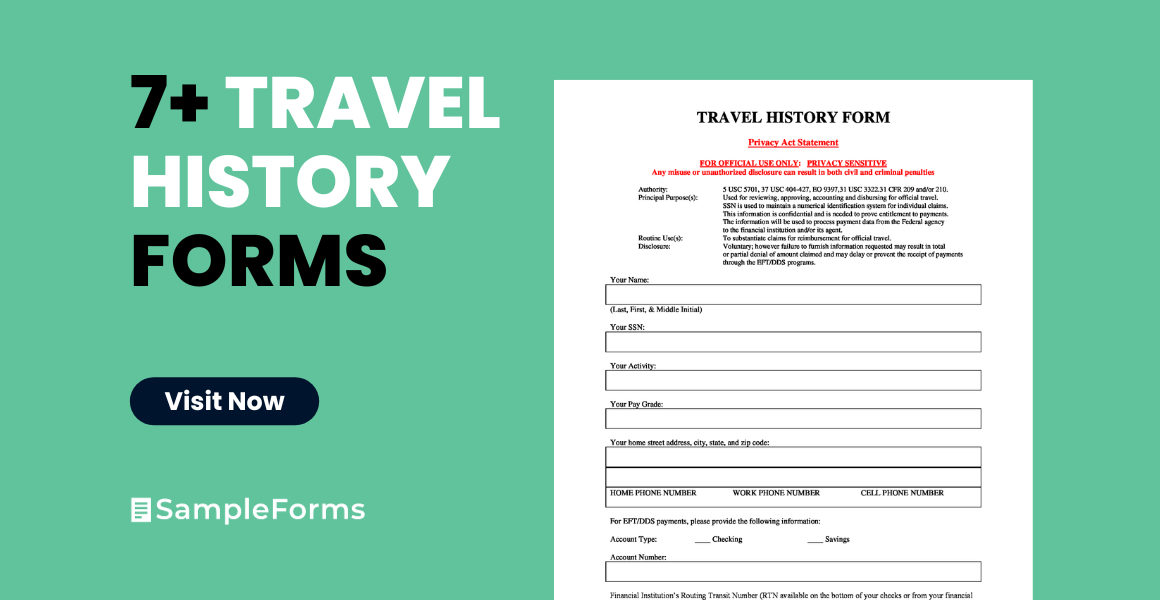
33+ Travel Request Form Templates
9+ sample travel health forms, 8+ sample travel registration forms.
- Free Travel Forms
- Travel Form Formats
What is a Travel History Form?
Technically, a travel history form is a documentation of the recent or previous travels of an individual. This form is often used in order to track where and when the business events were held, and who among of the employees have represented the company or the business. Nevertheless, these travel history forms are not just to document the places where you have recently been, but also to help you track different specific information such as the following:
1. The Travel Mileage
This mileage pertains to the number of miles traveled by the individual, as well as the volume of fuel used for the transportation. Tracking the mileage of the different trips or travels would help the business management conduct a proper budget allocation for the transportation fuel and other traveling expenses. This is to avoid the employees from spending their personal cash or money on behalf of the company. The details or information of mileage could also be documented with the use of mileage report forms .
2. The Travel Reimbursements
The reimbursements are with regards to the amount of money spent by the employee or representative during the business trips or travels held at a certain location. Therefore, these pertained expenses are basically with regards to the amount spent that were not catered from the travel budget given to the employee or representative. For those employees who are planning to request for reimbursements, they could fill out the reimbursement request forms.
3. The Travel Information
This is with regards to where the specific business events were held and for what reasons. This will help you keep or secure a document with all the business trips and travels that you and/or employees have been involved to make your business is known to the public.
Travel History Form in Doc

Travel History Form Details

Size: 35 KB
Travel History Information Form
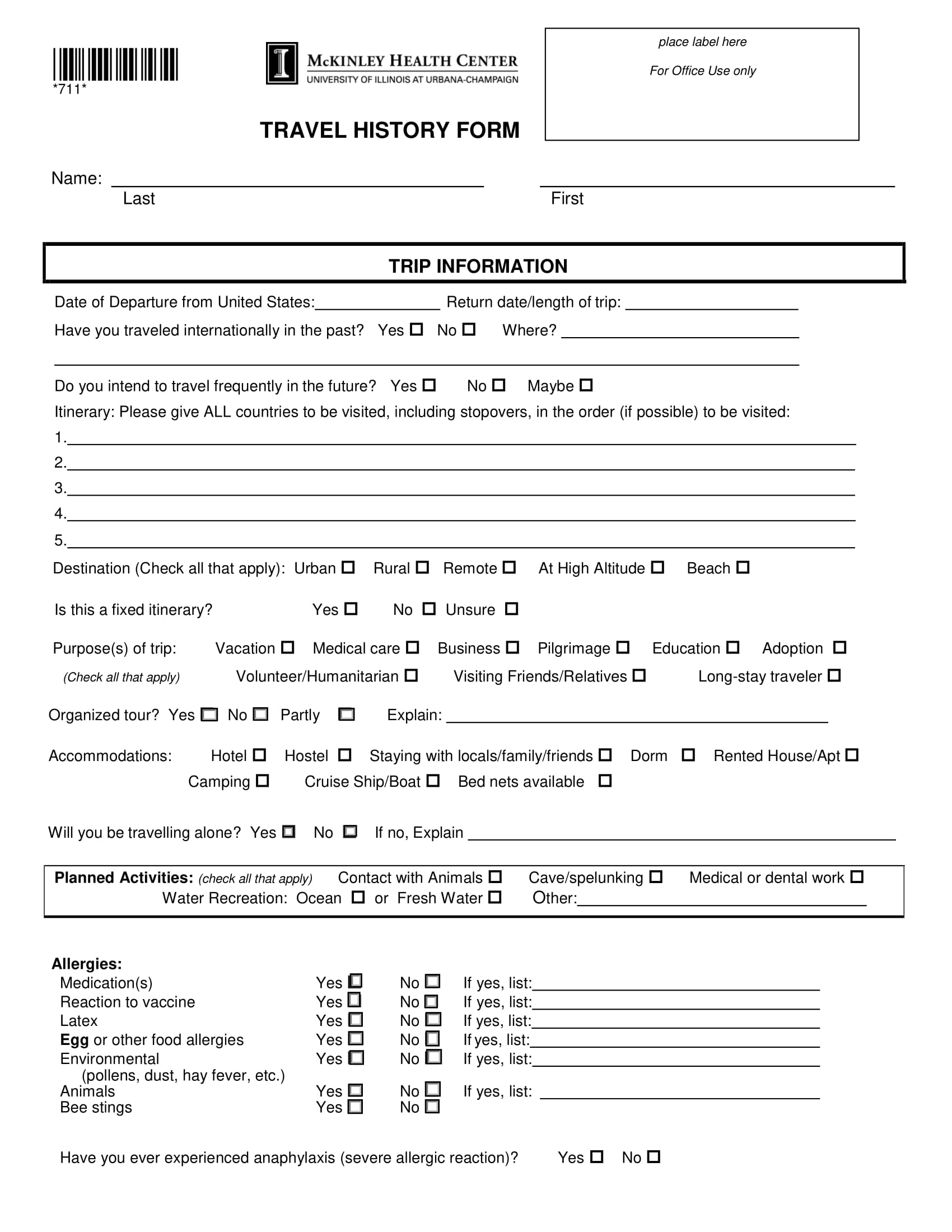
Size: 190 KB
The Essential Documents for Business Travels
All business trips or travels come with the requirements that should be submitted by the employee or the representative who is or are appointed to attend on behalf of the company. Therefore, refer to the following below to know what are the essential documents that each individual must provide. You may also see sample travel medical forms
1. Travel Medical Clearance
Employees are not permitted to attend any business trip or travel if they are not qualified for their medical clearance . Securing this kind of clearance is one way for the company or the management to reduce the liabilities when there are some circumstances such as incident. Therefore, it is mandatory that each employee is certified to be cleared of any health complications, which could be worsened when traveling.
2. Travel Approval Form
When the employee or the representative is confirmed to be qualified for any business travels, the travel approval form should be filled out with the necessary information such as the following:
- The travel itinerary that specifies the exact date and time for the trip’s departure and arrival to the specific location.
- The list of company equipment or properties that are brought to the event. This is in order to ensure that these properties are returned to the company after the event in proper condition. Otherwise, the employee will either be liable for replacing these or paying for the damages.
- The estimated cost for the whole trip or travel. This is in order for the management to provide sufficient amount of the travel budget.
- The employee’s declaration or confirmation that he or she has read and has fully understood the travel policies and procedures.
- The manager’s or head’s approval for the business travel involvement of the employee or the representative.
3. Travel Insurance Claim Form
This claim form is often utilized when an employee suffers an injury while traveling for business purposes. With the use of the form, all specific details are documented to help the management understand and justify the reasons for claims. However, the acceptance of this form by the insurance company does not necessarily mean that the company is admitting the liabilities. Nevertheless, the incident report will still be investigated and reviewed thoroughly, by basing on the statements and pieces of evidence.
4. Travel Expense Form
The travel expenses are mandatory to be documented on the expense form. This is in order for the management to track how much is spent on the different incidentals or expenditures to make sure that they allocate the budget effectively and is sufficient for the different business travels. With the expense report forms, the employee will be able to indicate how much he has spent on the company’s behalf for reimbursement. This could also be done by filling out the travel reimbursement claim form which is used to document all the details of when the personal money was spent by the employee.
Interactive Travel History Form
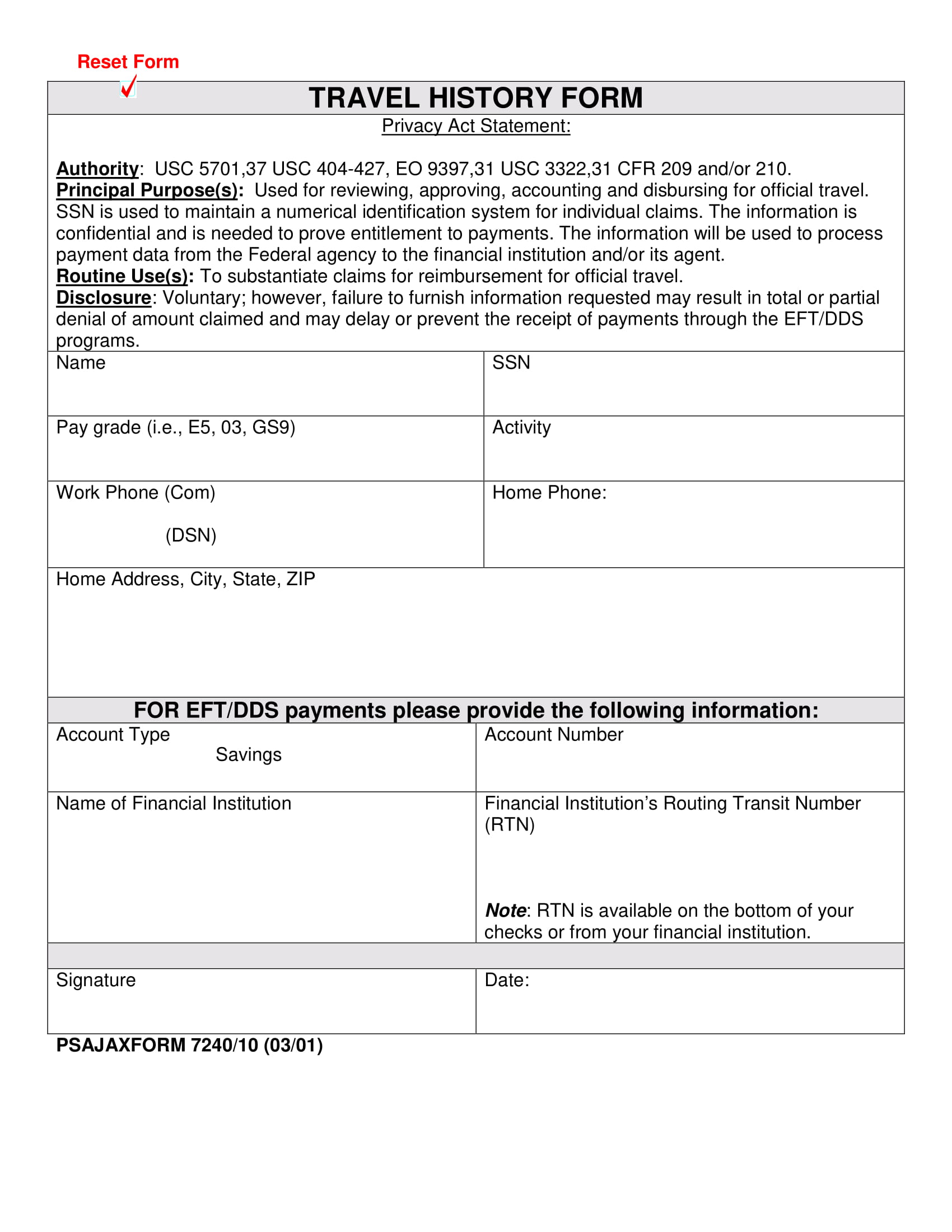
Fillable Travel History Form

Size: 321 KB
Trip or Travel History Form
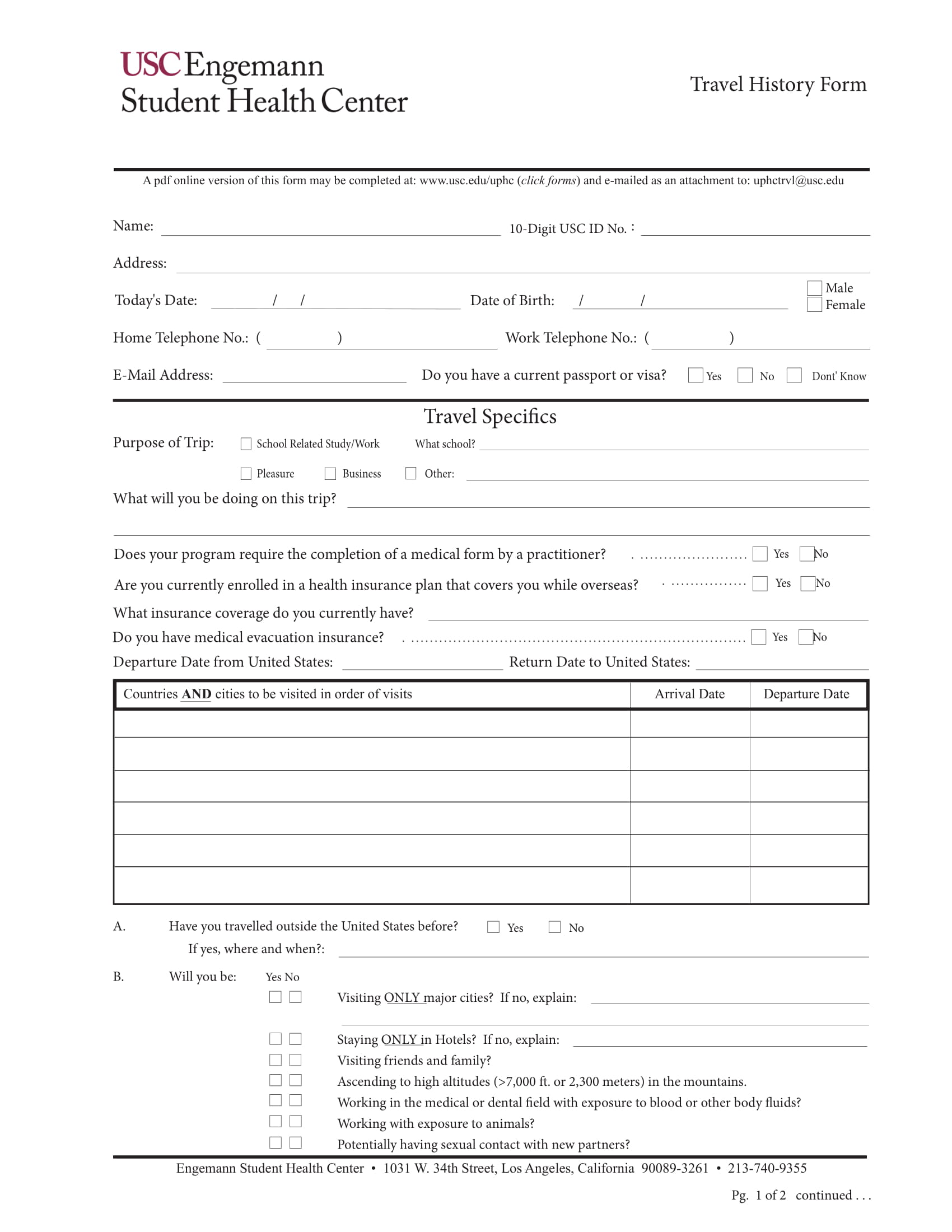
Size: 564 KB
The Importance of Travel History Forms
These forms designed for travel history are mandatory not only just to track the travel mileage reports , travel expenses, the reimbursements, claims, etc., but also for the following reasons:
1. When the person has been transmitted with a disease. It is important that the medical practitioners know where the person has been to determine if the disease was obtained from the places he or she recently was.
2. When the applicant applies for a job. Some companies would ask for the applicant’s travel history.
3. When the person applies for a security clearance and various kinds of thorough background checks are conducted. Technically, the travel history is also essential for the management to know the person’s recent travels for security purposes.
4. When the person files a visa application. The application form for a visa is often filled out when the applicant wishes to enter other countries and asked for the permission to stay over a period of time.
These are the common reasons why travel history forms are necessarily completed and documented.
The Essential Travel History Information
In recording the travel history, the few information that is necessary to be filled out on the form are the following:
- The representative or the employee information .
- The medical history information.
- The travel specifics or trip information.
- The budget allocated for each trip or travel.
- The travel itinerary with detailed specifications.
- Other attached documents that are necessary (medical clearance, travel approval or consent, etc.)
For some companies, they would often conduct a further assessment which includes the travel history of the individual for the past five years.
Student Travel History Form
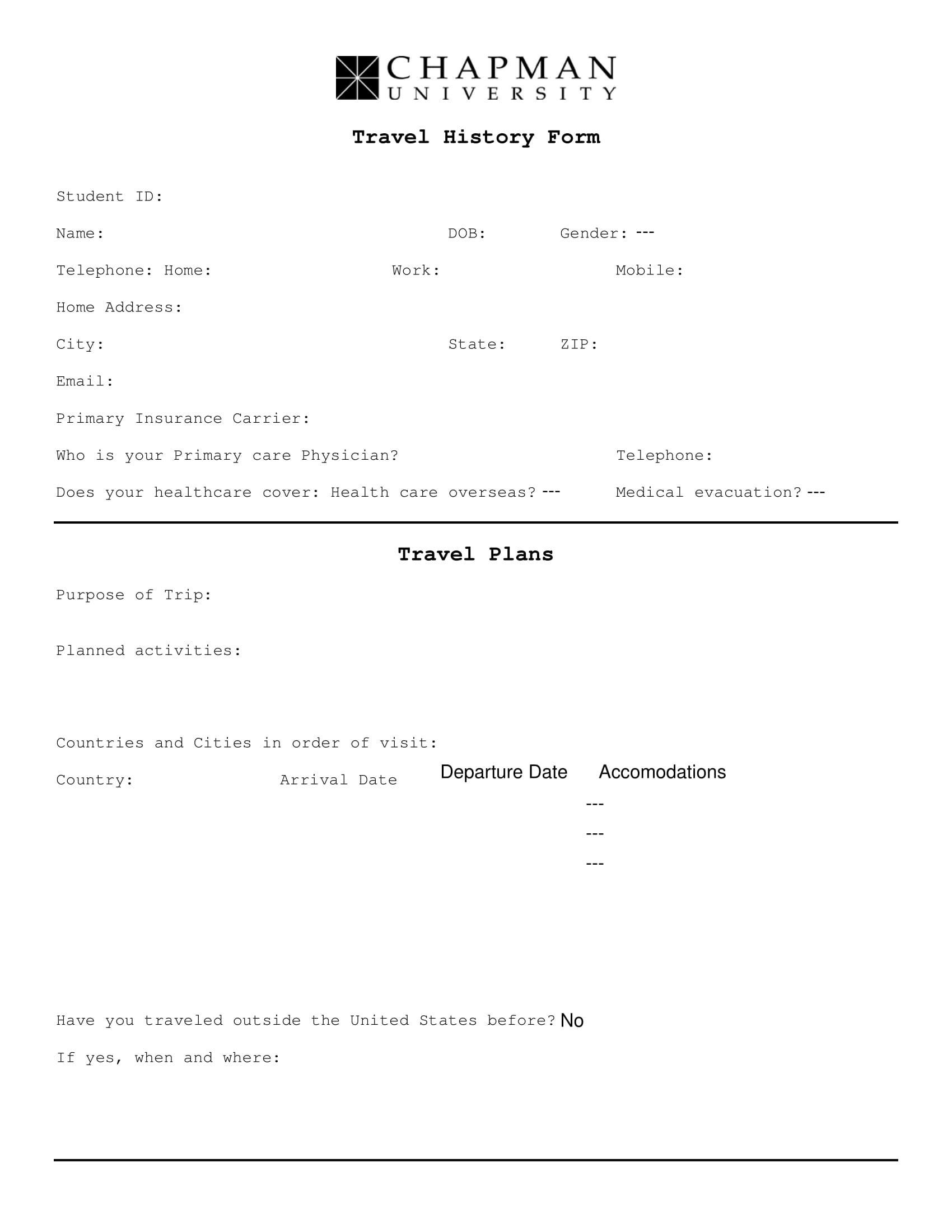
Size: 44 KB
Travel Medical History Form
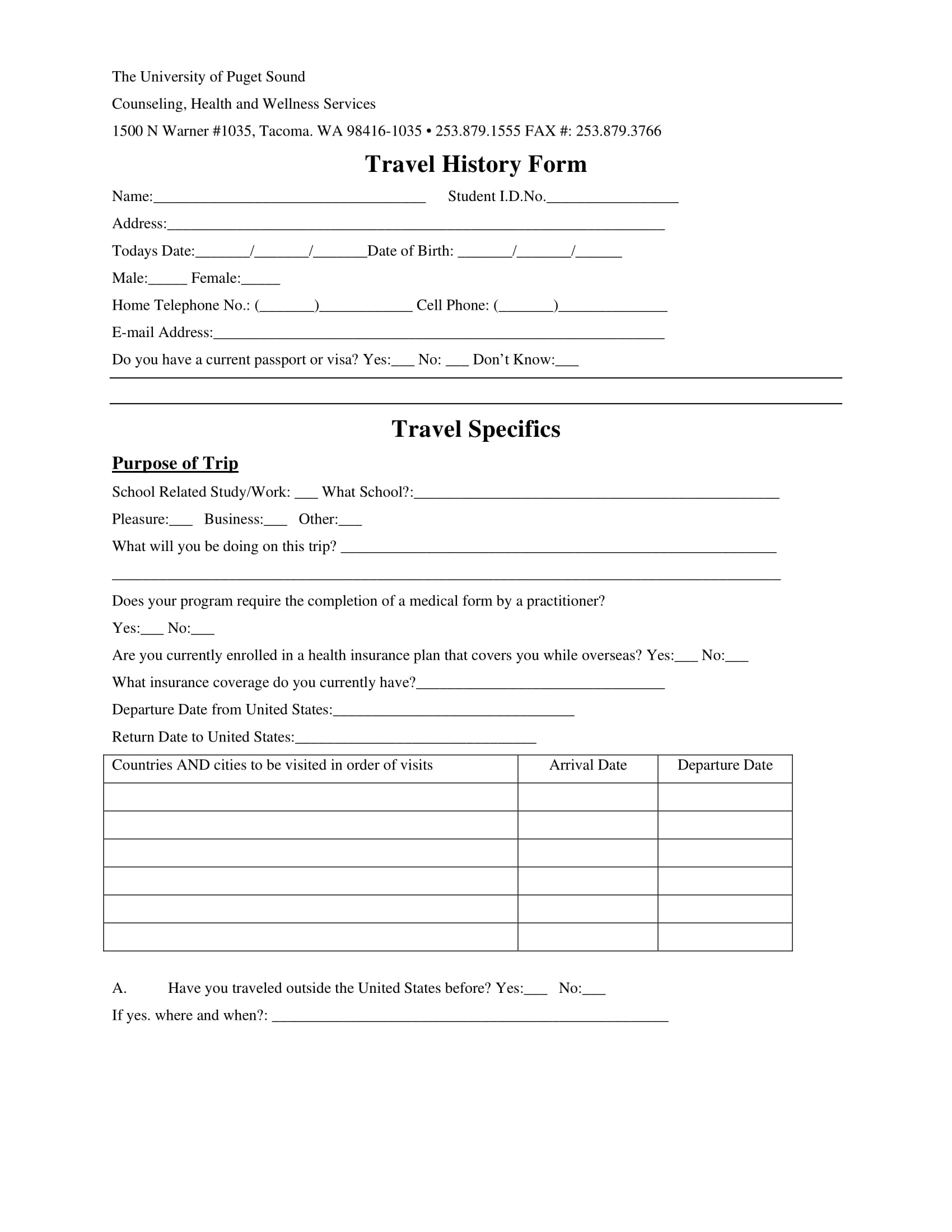
Size: 16 KB
Tips for Documenting Travel History
While documenting your travel history, there are a few things that you need to consider. Refer to the following below to know what these are.
1. Make sure that all information you input in the travel history form for travel is correct and accurate. Know that any falsification of the information would cause some consequences.
2. All expenditures must be documented in order for the management to track how much should be allocated for the travel budget.
3. Make sure that all information is finalized and documented using the travel expense report form.
4. Do not forget to list all the details and information with regards to the amount spent on personal cash. This is in order to notify and ask for reimbursement for the expenses incurred during the event, trip, or travel.
5. Require the employees or the representatives to take note of the details of what the event or trip was about. This is to know if the event is helpful for the business development and growth.
6. The forms should be submitted within the specified period of time in order to avoid any delays in the individual’s application or process. Submission of incomplete information would result in further interrogation with regards to the application or submission of the form.
7. The history forms that are required for some applications should be submitted to the authorized person in order for the process to be completed on time.
8. Review and finalize the details or information written in the travel history form before it is submitted.
These are few of the basic tips that you could refer to when documenting the travel history for the different business trips or events held for a particular purpose. You may also like sample travel approval forms
Therefore, these travel history forms are utilized for two main reasons: to document all the travel histories for different purposes and to keep track and list all the different expenditures in order to have a proper budget allocation for the whole trip or travel. To gain further information with regards to these forms, refer to the following downloadable forms for travel history provided for you in this article. You may also check out sample travel forms
Related Posts
7+ sample travel budget forms, 46+ sample travel request forms, 12+ travel proposal form samples, 9+ sample travel approval forms, 9+ travel authorization forms, 8+ sample child travel consent forms, 8+ travel expense forms, 8+ travel authorization sample forms, 7+ travel registration form samples, 7+ sample travel risk assessment forms, 6+ child travel consent form samples, 6+ travel document forms, 9+ travel questionnaire form samples, 7+ travel consent form samples, 6+ travel reimbursement forms, 8+ sample travel advance forms, 8+ sample travel consent forms, 8+ sample travel insurance claim forms, 8+ travel authorization form samples.

IMAGES
VIDEO
COMMENTS
TRAVEL DETAIL FOR LAST 5 YEARS. S:No Country Name Entry date Exit date. KARAÇI . Author: Çağrı Yüceer Created Date: 2/8/2018 12:39:58 PM ...
Day 1-2: Guide to Nemrut Dagi, Turkey (2022) Day 3-5: Sanliurfa and Göbekli tepe (11,000 years old!) Day 6-7: Mardin: ancient Silk Road town. Day 8-9: Diyarbakir. Day 10-12: Gaziantep (Zeugma mosaics and best food in Turkey) Day 13-14: Hatay: kunefe desert and Greek mosaics.
Anatolia, also called Asia Minor, is the peninsula of land that today constitutes the Asian portion of Turkey. In geographic terms Anatolia may be described as the area in southwestern Asia bounded to the north by the Black Sea, to the east and south by the Southeastern Taurus Mountains and the Mediterranean Sea, and to the west by the Aegean Sea and Sea of Marmara.
Anatolia, or Asia Minor Turkish Anadolu, Peninsula forming the western extremity of Asia. It is bounded by the Black Sea to the north, the Mediterranean Sea to the south, and the Aegean Sea to the west. Its eastern boundary is generally marked by the southeastern Taurus Mountains. Anatolia is roughly contiguous with the Asian portion of the ...
The history of Anatolia (often referred to in historical sources as Asia Minor) can be roughly subdivided into: Prehistory of Anatolia (up to the end of the 3rd millennium BCE), Ancient Anatolia (including Hattian, Hittite and post-Hittite periods), Classical Anatolia (including Achaemenid, Hellenistic and Roman periods), Byzantine Anatolia (later overlapping, since the 11th century, with the ...
"The period from 1000 to 1400 in Anatolia and the Caucasus is a time of Turkic and Muslim expansion at the expense of the Byzantine empire's eastern territories. The arrival of the Crusaders from the west, especially the conquest of Constantinople by the Fourth Crusade in 1204, further undermines the civil authority of the Byzantine state. The advance of the Mongol armies from the east ...
Basic requirements: Your valid passport for minimum 6 months (From the date of travel) 2 photographs with white background (5cm x 5cm). Front pose without sunglasses, veil, cap, turban (80% face - 20% body). Other mandatory and supporting documents mentioned on Embassy / Consulates checklist as per your desired visa category.
ANATOLIA is full of ART, HISTORY, ADVENTURE, BEAUTY and LOVE ️ ... Travel Anatolia. Library of Celsus is an ancient Roman building in Ephesus, Anatolia, now part of Selçuk, Turkey. Ölüdeniz (literally Dead Sea, due to its calm waters even during storms; official translation name Blue Lagoon) is a small neighbourhood and beach resort in the ...
I wanted to share with you my visa process experience. And wanted to tell you how you can apply for turkey visa in Pakistan. so, in this video I tried to giv...
Apply for or Retrieve Form I-94, Request Travel History and Check Travel Compliance. International travelers visiting the United States can apply for or retrieve their I-94 admission number/record (which is proof of legal visitor status) as well as retrieve a limited travel history of their U.S. arrivals and departures.
Timeline of Turkey's History. The history of Anatolia & Turkey from 23,000 BC to 1950 AD. Karain Cave. Continuously inhabited by humans for 25,000 years… Neolithic Göbekli Tepe. Humankind's first temple was built by hunter-gatherers at Göbekli Tepe in southeastern Anatolia even before the invention of agriculture and pottery. More…
Form: Travel History Information This application is made available free by Immigration, Refugees and Citizenship Canada and is not to be sold to applicants. Cette trousse est également disponible en français. 1 Travel History Information Form To be complete by ALL applicants
8 x 8 in / 20 x 20 cmGeoPressed Matte. A rich and versatile collection; it comes with a new palette of both classic and dynamic colors that are expressed in tiles and trims and decorative tiles.
Anatolia Travel. There's seemingly no end to the delights of Anatolia. Beaches on the Black and Mediterranean Seas give way to wetlands, high plateaus, and the unique Cappadocian hinterland. Culturally important for millennia, ancient cities dot the region. Meanwhile, modern Turkey can be explored in all its magnificence in Ankara and Konya.
1. Make sure that all information you input in the travel history form for travel is correct and accurate. Know that any falsification of the information would cause some consequences. 2. All expenditures must be documented in order for the management to track how much should be allocated for the travel budget. 3.
A Travel History Report is a record of a traveller's entries, exits or both into Canada. This information is collected by the Canada Border Services Agency ( CBSA ). Retention period for a Travel History Report is 15 years. The CBSA began collecting traveller exit information on foreign nationals (excluding American citizens) entering the ...
Title: Travel History Form Author: Joseph R. Ineck Subject: Travel History Form Keywords: Travel History Form Created Date: 6/13/2017 3:51:07 PM